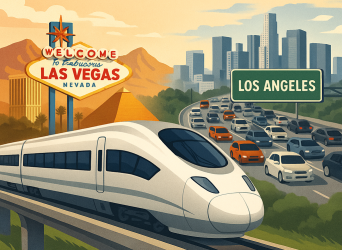Transforming Infrastructure: The Brightline West High-Speed Rail Project

The Future of American Rail
Imagine cutting your travel time from Las Vegas to Los Angeles in half—all while reducing highway congestion and carbon emissions. The Brightline West High-Speed Rail Project is set to redefine regional transportation, bringing sustainable, high-speed transit to a growing corridor.
Funded through a mix of private investment and federal infrastructure initiatives, the project’s success hinges on innovative engineering, strict quality control, and eco-conscious construction methods. But how does Brightline West overcome the technical and logistical challenges of high-speed rail in the U.S.?
The Vision Behind Brightline West
Brightline West is more than just a train—it’s a blueprint for modern infrastructure.
- Route: 218 miles connecting Las Vegas to Rancho Cucamonga, CA.
- Speed: Expected to reach 186 mph, making it the fastest intercity rail in the U.S.
- Technology: Uses electric train sets for emissions reduction and efficiency.
Unlike traditional rail lines, this project follows existing highway corridors, minimizing land acquisition issues and speeding up approvals from agencies like the Federal Railroad Administration (FRA).
Engineering Challenges & Solutions
Building high-speed rail in the American Southwest presents unique obstacles:
1. Desert Climate & Thermal Expansion
- Tracks must withstand temperature swings from 30°F to 115°F.
- Engineers use continuous welded rail (CWR) to prevent rail gaps and warping.
2. Right-of-Way Coordination
- Close collaboration with California DOT and Nevada transportation agencies ensures minimal disruption to highways.
- Elevated sections bypass major interchanges, maintaining traffic flow.
3. Station Infrastructure & Integration
- Intermodal stations connect to existing transit hubs, allowing seamless passenger flow from rail to urban areas.
Sustainability & Environmental Impact
Brightline West isn’t just about speed—it’s paving the way for greener infrastructure.
- Carbon Reduction: Electric-powered rail cuts emissions by 70% per passenger-mile compared to driving.
- Energy Efficiency: Regenerative braking captures kinetic energy, lowering electricity consumption.
- LEED-Certified Stations: Stations incorporate solar panels, water recycling, and smart cooling systems.
Industry experts, such as Dr. Mark Hastings, a transportation consultant, praise the project:
“Brightline West sets a precedent for sustainable high-speed rail in the U.S., balancing efficiency with environmental responsibility.”
Economic & Urban Development Benefits
Beyond transit improvements, Brightline West drives economic expansion:
- Job Creation: Over 10,000 construction jobs during development.
- Local Growth: Rail access fuels hospitality, retail, and real estate investment near stations.
- Tourism Boost: Faster Vegas travel could increase visitor volume by millions annually.
According to the U.S. Department of Transportation (DOT), similar rail projects have yielded $2–$4 billion in regional economic benefits over a decade.
Case Study Spotlight: Key Milestones
Brightline West has hit several milestones since its inception:
✅ 2020: Environmental approvals secured.
✅ 2022: Federal funding commitments strengthened.
✅ 2024: Construction officially begins along I-15 corridor.
✅ 2028: Targeted opening for passenger service.
Real-world comparisons include California’s High-Speed Rail Project, but Brightline West takes a more focused, streamlined approach to deployment.
Lessons for Future Infrastructure Projects
What can construction professionals learn from Brightline West?
- Integrated Planning: Early alignment with state agencies speeds approval.
- Modular Engineering: Prefabrication accelerates build timelines and improves consistency.
- Public-Private Collaboration: Leveraging private-sector investment strengthens financial viability.
Conclusion: A New Era for American Rail
Brightline West symbolizes America’s potential in high-speed rail—blending innovation, sustainability, and economic development. As the project advances, it sets the stage for future expansions beyond the Southwest, reshaping transit options nationwide.
Are we witnessing a turning point for modern infrastructure in the U.S.?